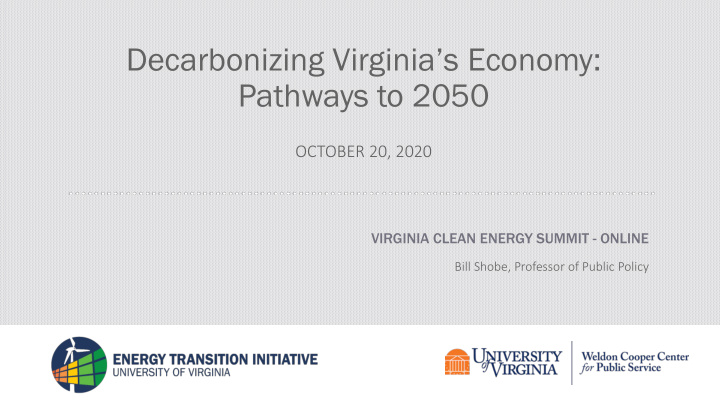



Decarbonizing Virginia’s Economy: Pathways to 2050 OCTOBER 20, 2020 VIRGINIA CLEAN ENERGY SUMMIT - ONLINE Bill Shobe, Professor of Public Policy
Energy Transition Initiative A center of excellence for rigorous analysis of Virginia energy systems 1. Help chart pathways and policies for net zero carbon by 2050 2. Identify opportunities and roadblocks on the road to zero carbon 3. Promote informed, engaged and inclusive decision making on Virginia’s energy future 2
Thanks to our supporters and partners 3
The Greatest Resource Why professors are generally so hopeful about the future… Thanks to our dedicated army of student volunteers. 4
DECARBONIZING VIRGINIA A WHOLE-ECONOMY PERSPECTIVE
No one who is paying attention can doubt what Virginia has at stake 6
Virginia moves into a leadership role • With Virginia Clean Economy Act, Virginia joins the “2050 Club” of states To decarbonize the whole pursuing aggressive decarbonization economy, we need to goals plan now • VCEA focused mainly on electric power • Next step: address the 70% of • Delay is costly emissions from transport, buildings and • Integrated planning industry pays huge dividends • Consider energy equity in all stages of decarbonization 7
We need to address emissions from the whole economy Electricity accounts for only ~ 30% of Virginia’s CO2 emissions. Transport accounts for nearly half. Getting to net zero requires reducing emissions from transport, buildings and industry, along with electricity. 8
Not to spoil the punchline, but… • Decarbonization by 2050 is achievable and affordable • It generates many economic benefits: money, health, climate • Different policies and priorities imply a different resource mix • Careful planning and policy design pay big dividends • Coordination between state and local governments is essential • A quicker start means lower long-run costs 9
MODELING POSSIBLE PATHWAYS EXPLORING ENERGY FUTURES FOR VIRGINIA
The Four Pillars of Cost-effective Decarbonization 1. Efficiency and responsiveness in end-use 2. Electricity sector decarbonization 3. Electrify everything (almost) 4. Capture carbon (to sequester or use) 11
Our Initial Model POSSIBLE POLICY PATHWAYS, NOT FORECASTS • Modeling partner: Evolved Energy Research • Scenario analysis • Energy system optimization • Realistic treatment of • Technology • Virginia-specific resources • Existing Virginia law 12
The Scenarios: Common Assumptions • All scenarios achieve net zero carbon by 2050 • Existing law, including VCEA, RGGI, etc. • NREL “Mid” technology costs • No more than 1% of land area in utility-scale solar • Keep current nuclear fleet (re-license 4 existing units) • $0.01/kWh subsidy to distributed solar • Nationwide decarbonization along with Virginia 13
The Scenarios: Specific Assumptions BASELINE OF NO DECARBONIZATION POLICIES Four decarbonization scenarios: 1. Net zero: least cost given current technology 2. Constrained solar land use and no new nuclear 3. Slow consumer adoption of EVs and building electrification 4. Rapid technological innovation 14
Modeling: Key Results • Solar, offshore wind and existing nuclear are the foundation • Storage complements solar • Natural gas capacity remains but transitions to carbon-free fuel • Hydrogen (and syn fuel) plays an increasingly important role • Bio-based synthetic fuels are imported, electricity is homegrown • Some negative emissions (BECCS) will be needed 15
There are Enough Resources to Meet the Load 16
Modeling Results: Capacity 17
Modeling Results: Generation 18
Modeling Results: Hydrogen 19
Modeling Results: Zero Carbon Fuels 20
KEY INSIGHTS FROM OUR ANALYSIS INSERT SUBHEADING
Modeling Results: Increasingly Homegrown Energy • Decarbonization substitutes made-in-Virginia energy for fossil fuel imports • Investment in local clean electricity and end-use equipment is offset by reduced spending on natural gas and refined petroleum 22
Key Lessons • Timely adoption of electric technologies is critical • Transport and buildings, in particular • Slow adoption requires more imported biofuels • Constraints on solar and new nuclear are expensive • Pushes mix to rooftop solar, syn. gas, imported electricity • Innovation increases the benefits for Virginia • State and local governments need to coordinate • No new fossil sources (or pipelines) needed for reliability • Natural gas capacity becomes intermittent, carbon-free generation 23
How Shall We Proceed? 2020s 2030s 2040s • No more fossil infrastructure • Electrify everything (almost) • Complete electrification of transport and buildings • Start adding renewables • Accelerate solar and wind capacity (VCEA, check) deployment as costs fall • Develop carbon-free gas to replace natural gas backup • Move on electrification and • Expand storage and begin efficiency in transport and relegating gas to backup role • Deploy BECCS at scale for buildings hydrogen and negative • Carbon capture for carbon • Keep existing nuclear recalcitrant sources (relicense) (industry) • Convert remaining natural gas plants to carbon-free • Build expertise in shift to • Begin developing BECCS sources modern grid architecture and hydrogen infrastructure • Invest in innovation • Evaluate potential new nuclear technologies • Pilot new technologies and techniques 24
The Economics of CleanTech • Use RGGI and TCI markets, cap emissions on a path to zero • The price induced on emissions makes everything easier • Costs of own energy resources have fallen • So we make it ourselves, it’s cheaper • Electrification saves money and reduces pollution • The skills needed are the skills available • Workforce development will expand opportunities • Innovation makes it likely that Virginia will produce more of its own energy needs 25
The problems which the spaceship earth is going to present, therefore, are not all in the future by any means, and a strong case can be made for paying much more attention to them in the present than we now do. Kenneth Boulding, economist The Economics of the Coming Spaceship Earth 1966 Thank you SHOBE@VIRGINIA.EDU ENERGYTRANSITION.COOPERCENTER.ORG
Recommend
More recommend